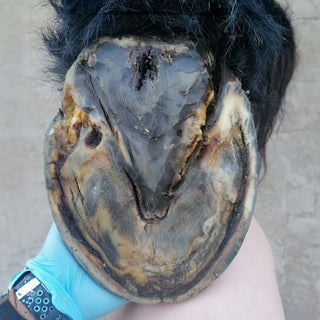Basically, shod and barehoofed horses suffer from the same hoof diseases. However, the nailed-on horseshoe means that the causes, symptoms, diagnosis and treatment are different.
What is a hoof abscess in horses?
A hoof abscess is an infection in the hoof caused by germs (bacteria and fungi) with severe inflammation. Many hoof abscesses rise from the white line, often also in the corner strut area, upwards into the corium. This is often not visible from the outside. They are then located in the innervated and heavily supplied with blood hoof areas. An injury to the sole of the hoof, e.g. caused by a nail kick or nailing by the farrier, can also result in a hoof abscess.

Fig. 1: Open hoof abscess in the corner strut area
Hoof abscess symptoms
Within a very short time, hoof abscesses lead to severe lameness. This is because the disease and infectious processes not only cause inflammation, but often also excess pressure in the wound area, which cannot drain to the outside due to the closed horn capsule. Many horses exhibit severe lameness or put weight on the affected leg no longer at all.
If a hoof abscess is not found or treatment is started late, the abscess can also find its way up to the coronet band and drain there at the coronary band. Treatment then becomes much more complex and takes longer. In this case, larger areas of the wound often have to be exposed, i.e. parts of the hoof wall have to be removed to allow irrigation (drainage) through the wound channel.
Diagnosis and causes of a hoof abscess
The diagnosis is made by the vet or farrier, initially by taking impressions of the wall and sole using hoof testers. A shoe should be removed for this purpose. The diseased hoof area can usually be localized quickly by applying pressure on the hoof.
Cause in shod horses are often ascending decomposition processes in the white line in the area of the nails. In bare hoofed horses, on the other hand, it is usually small, pointed stones in the white line, often several stones on top of each other. Thrush or injuries in the frog area can also be responsible for abscess formation. Hoof abscesses can cause severe pain in the horse.

Fig. 2: Hoof abscess in the central frog cleft due to thrush
 Treatment of hoof abscesses in horses
Treatment of hoof abscesses in horses
The hoof area is examined for penetrating foreign bodies or ascending decay channels. Usually only small black dots or tiny channels can be seen in the white line.
This area is then opened upwards with a fine hoof knife or a small burr. If the canal enlarges, an inflammatory secretion often drains quickly due to the excess pressure. You will immediately notice a The horse "breathes a sigh of relief" as the main pain caused by the excess pressure in the abscess area is gone.
Further treatment is then carried out by further opening or exposing the wound area. As little horn as possible should be removed, but as much as necessary. The damaged hoof area should then be rinsed daily using suitable disinfectant solutions.
If the horse is shod, the shoe can then be nailed back on quite quickly. The wound cavity can be refilled daily with a swab soaked in disinfectant solution and fixed with adhesive tape. Once the horse is free of lameness, you can start exercising again.

Special features for barehoofed horses
At this stage, the bare hoof should be protected with a clean, dry bandage or a hoof boot. Under no circumstances should the diseased hoof be left unprotected. Depending on the size of the defect, this healing phase can last from a few days to several weeks.

Chances of healing hoof abscesses in horses
Quickly recognized, well-treated hoof abscesses are normally largely healed within one to two weeks. In the case of bare hooves, however, you should consider protecting the affected hoof until the horn wall or sole has grown back completely. Depending on the severity, the vet will initially prescribe anti-inflammatories, painkillers or even antibiotics.


